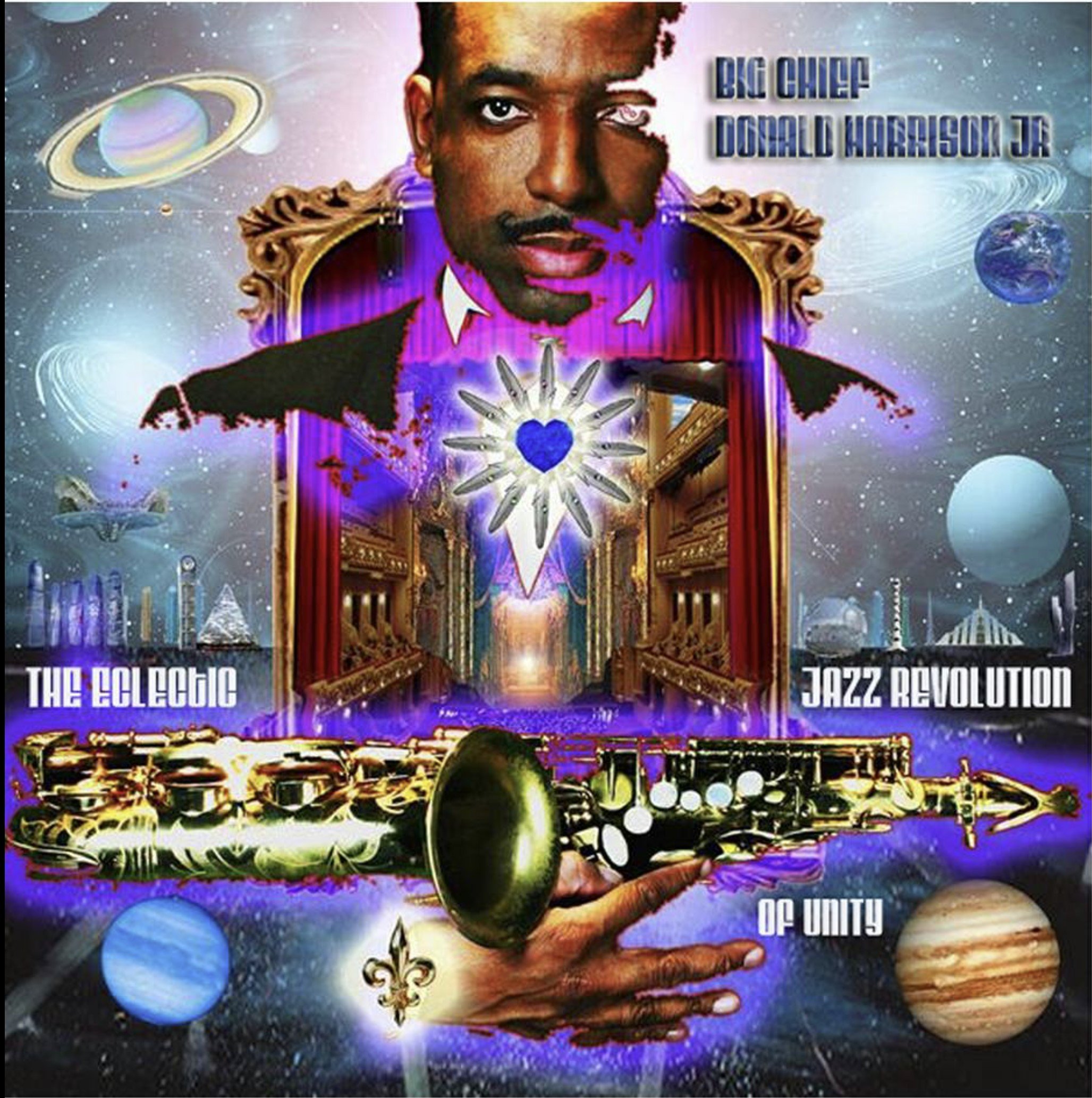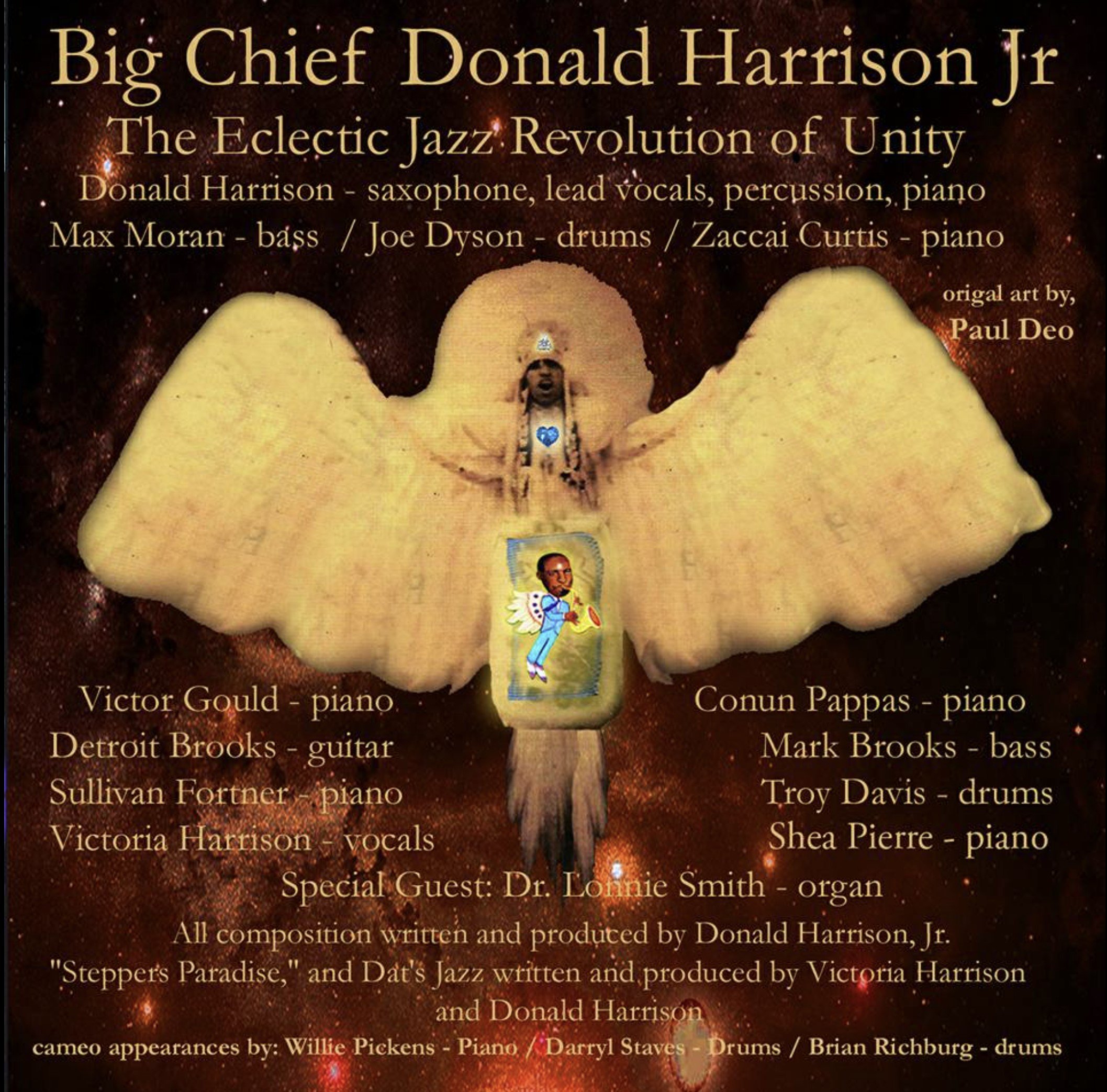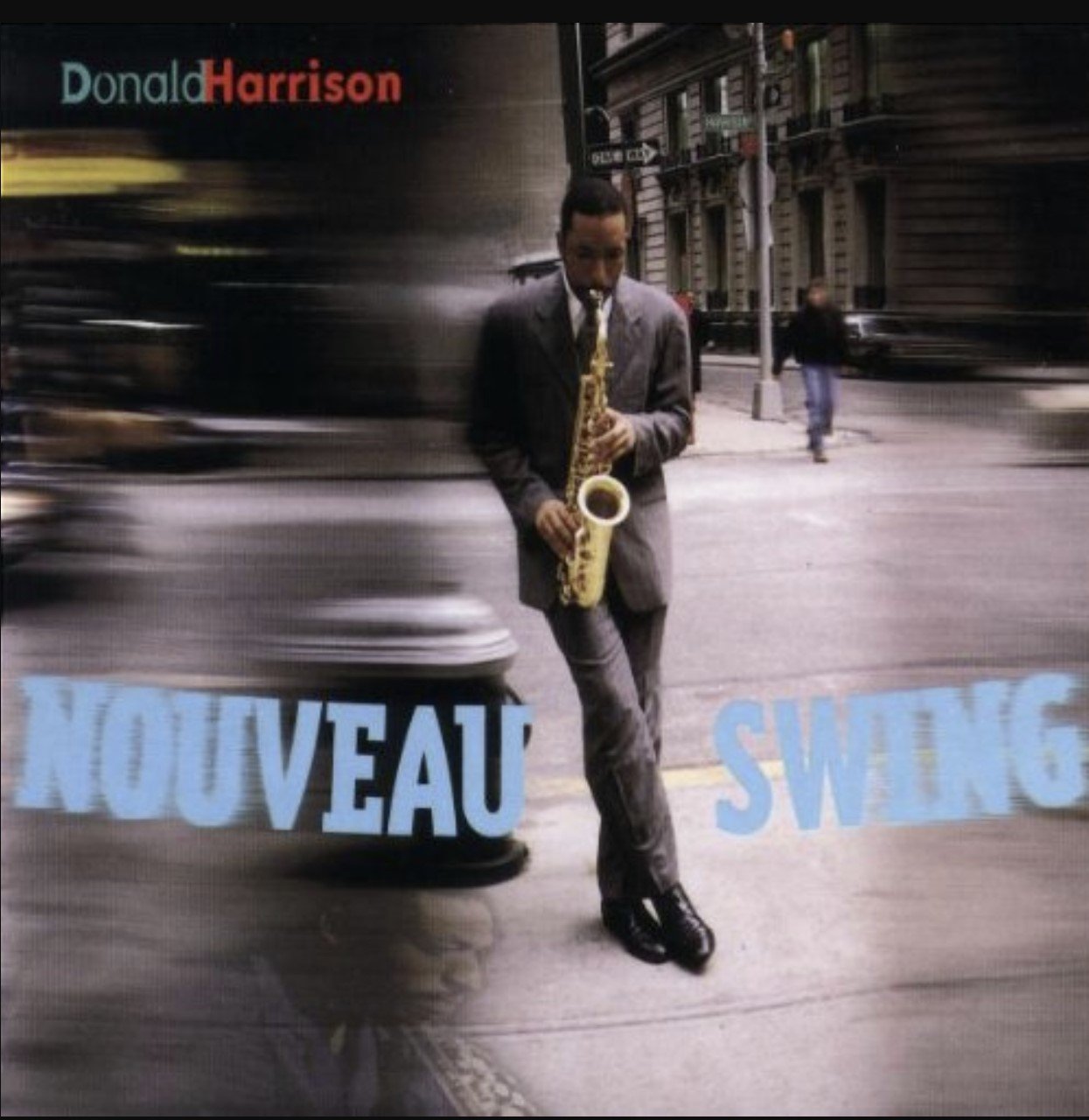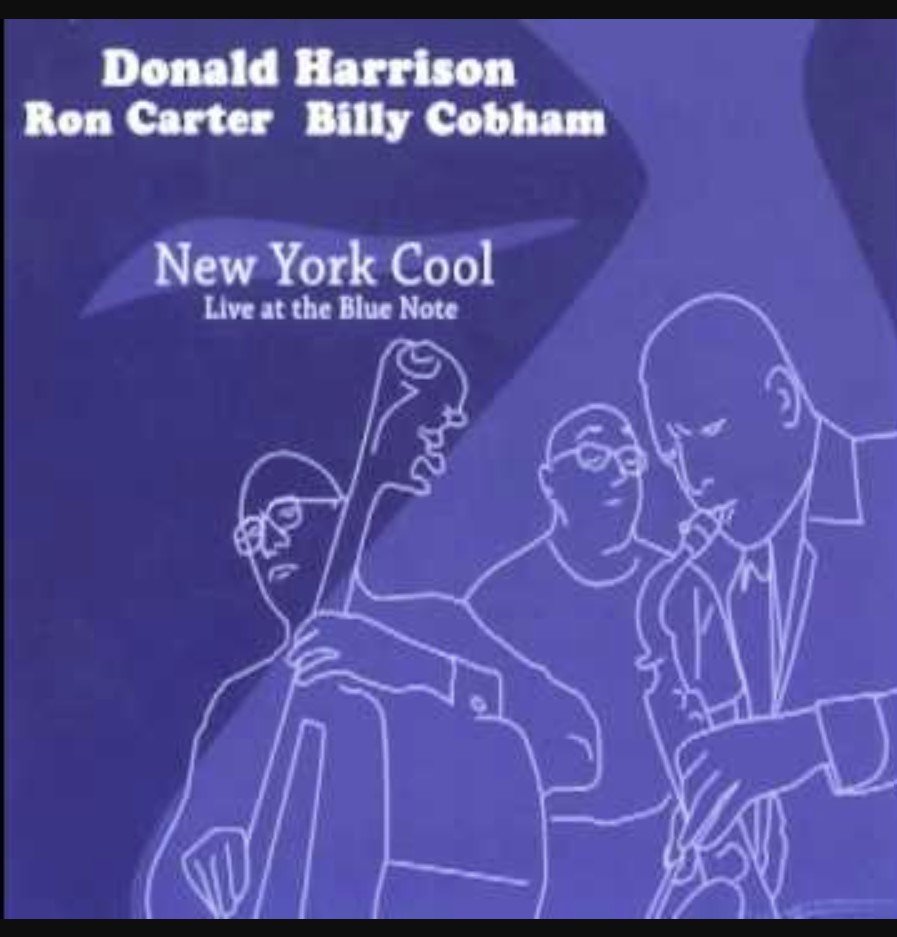Honoring Jazz Great Donald Harrison
(Front and Back cover of The Eclectic Jazz Revolution of Unity)
Six years ago, NEA Jazz Master Donald Harrison asked me to write the liner notes for a double CD recording that captured the astounding diversity and depth of his mastery of musical forms, as well as his own innovations, all grounded in his experiences with and study of grandmasters of music. One week ago, Harrison suffered a heart attack while touring in Hawaii. Fortunately, he is back home in New Orleans, recovering and taking care to recuperate while under medical supervision and the care of his loving wife and family, as hundreds of his friends, admirers, and fellow artists send him well wishes and prayers.
The double CD, titled The Eclectic Jazz Revolution of Unity, should be released this fall; I share the following notes in honor of Big Chief Donald Harrison: may he continue to rise in health and well-being, and to grow from strength to strength.
Meta-Morpheus: Donald Harrison’s Eclectic Jazz Revolution of Unity
Donald Harrison’s musical universe is vast, populated with planets called “genres”—orbits of stylistic convention. Jazz is his sun, the blues his moon, with soul and funk the earthy undertone of his universe, yet, as you’ll hear, his planetary reach extends into far regions, musical galaxies.
Imagine a wheel within a wheel centered by a black hub. The straight lines extending from the hub to the edges of the inner wheel become wavy lines swirling to the circumference of the next wheel. Harrison is the hub; the lines are multi-generations of masters directly influencing his integral conception and execution. The hub vibrates; the inner wheel begins a slow clockwise spin as the outer turns counter-clockwise. As velocity increases the mystic wheels transform into a single black dot amidst a rotating circle in your forehead, sending rainbow rays of light to the stars.
Such a vision of cultural and spiritual metamorphosis infuses this two-cd set, a sample of Harrison’s musical creativity over the past 12 or so years. So beware, or, rather, be-aware that pre-conceived ideas of style or genre will be violated. Even those familiar with the range of Harrison’s musical interests may be shocked by the end of this eclectic trip.
In the 1980s, he reasoned through intuition that the African-derived music of his birthplace New Orleans had elements of swing, soul, and funk. Adding more parts to the whole, he birthed Nouveau Swing, where New Orleans elements dance with hip hop, reggae, rhumba, and rock.
Yet his touring and recordings with masters such as Ron Carter, Eddie Palmieri, Elvin Jones, McCoy Tyner, Art Blakey, Roy Haynes, and Miles Davis grounded his reverence for tradition while pushing him, perpetually, to further dimensions. Harrison engages in an ongoing dialogue with various forms of music, altering what cultural sage Albert Murray calls the “emotional scale” of these styles along the way.
That’s how nouveau swing morphed into what he calls “quantum jazz,” an idea Brown University physicist Stephon Alexander gravitated to for his 2016 book, The Jazz of Physics: The Secret Link Between Music and the Structure of the Universe.
"My quantum jazz concept came from discovering that I could incorporate how the universe works into a musical landscape,” Harrison says. “I now see, hear and understand how to utilize the way light travels, concepts of three- and four-dimensional space, and the way neutrons, protons, electrons, photons and atoms interact into jazz and other styles of music."
The first disc begins with this innovation.
Harrison’s group eases us into his new paradigm on the first cut, “Ron Carter.” The rhythmic and time elasticity of Miles Davis’s New Testament quintet in the 1960s is a clear antecedent. The song form employs breaks and mood shifts via dynamics. Harrison’s note flurries employ smooth and hard articulation, and call upon the spirits of Miles Davis and Wayne Shorter, as he’s backed by a breathing rhythm section that keeps time but isn’t bound by it.
“Quantum Leap” is the concept in full force and effect, meta-swing, the song maintaining resilient forward motion yet skipping time at will, hopping and shifting, with Harrison calling upon saxophone ancestors as he makes a definitive statement of his own. “The Amazing Demme” employs this groove-time-shift method in waltz time. Harrison’s challenging saxophone technique is the highlight of “Crest Rider,” octave leaps relaying the melody “in different strata.”
The ensemble shifts again for “Dat’s Jazz,” but this time innovates on the ground, via vernacular, bottom up. An extension of nouveau swing, “Dat’s Jazz” features Harrison vocalizing the mind, body and soul message of the music:
Check it:
I hope you hear me, cognoscenti
‘Cause I’m talking to you, and here’s the cue
To pass down
The true essence of a higher echelon
Of blues-drenched music
That was born
For a people whose only outlet
Was to look inside, and
Find the beauty
And then their light shine
For the world to see
Jazz music is what that be, jazz music is what that be.
Harrison’s wakeup call to musical integration references Pops, Miles, Bird, and ‘Trane, and responds with funk, R&B, line dancing, scat, and swing, even shades of the vocal harmonies of Take 6. If we can bridge musical divides, Harrison implies, we can bring the people together.
“The Mysterious One” feels transitional, its modal sound evoking Miles Davis’s electric period. “The Bamboula Effect” opens swinging, and transitions to a New Orleans bamboula rhythm mixed with the swing beat. Along with “Hu-Tah-Nay” on disc two and the astounding three-part suite that closes the recording, this cut extends and elaborates his downhome roots and his inheritance of the role of Big Chief of the Congo Square Nation Afro-New Orleans Cultural Group—a unique status among jazz musicians. His ballad version of “When the Saints Go Marching In,” recorded after Katrina, demonstrates how such a “happy song could show the melancholy” mood of the time. On this cut especially, the bell of Harrison’s alto sax rings with air stream warmth so his feelings would be “more evident.”
“The Magic Touch” is an excursion into the instrumental R&B zone. The acoustic version, more intensely jazz in improvisational drive, is on disc one, with the smooth jazz version, featuring Chris Botti and Chuck Loeb, on disc two. Check out how Harrison adapts the formula of what is called smooth jazz “to create a different swagger for modern jazz.”
“Tippin’ with Roy,” drummer Troy Davis powering in the spirit of elder master Roy Haynes, is a dramatic, no-nonsense tune swingin’ in the bridge. By the end, the ensemble intensity invokes ancestors: Harrison pours sonic libations to John Coltrane’s sheets of sound and late-period force. The ballad “When Mary Sings” is a gentle rhapsody with inflections from soul, jazz, and European chamber music.
Ending disc one with yet another innovation, Harrison’s “The Sand Castle Hunter” is advanced funk/swing—or high-level fusion— with modulations and chromatic chord play. Runs and asymmetric figures go up and down stairs of hard groove; Latin jazz is incorporated via allusions to a famous Dizzy Gillespie song you’ll likely recognize.
The first seven songs of disc two are powered by a rhythm section led by organ master Dr. Lonnie Smith, with mellow funk (“The Doctor is In”), gritty funk (“James Brown”), straight and funky blues (“Blues People” and “November Funk”), a New Orleans chant jazz-style (“Hu-Tah-Nay”), relaying the varieties of organ jazz experience. The first song on side two, however, is something even more.
“TLC,” a sassy uptempo number, features perhaps Harrison’s greatest short improvisation on record. His articulation draws from the three Mount Rushmore alto saxophonists of the first half of jazz history—Johnny Hodges, Benny Carter, and Charlie Parker, with bebop lines divined from his early training with Barry Harris, and blues systems derived from Eddie “Cleanhead” Vinson. Riding waves of swang like it ain’t no thang, all these influences transmute through the hub of Harrison’s honed style, quantum jazz flurries interspersed like blues up and down, not missing a beat or change. This song will have your insides dancing, a flying magic carpet ride in a lucid dream.
The New Orleans native learned the modern Chicago stepping dance and was inspired to pen the happy, clapping “Stepper’s Paradise,” a laid-back backbeat tune with Harrison and his daughter Victoria on lead vocals. Put this song on to kick off any soulful house or club party and watch heads begin (and continue) to bob.
The recording closes with Harrison’s first orchestral recording, a three-part suite, “Congo Square.” At one minute, part I features a tribal chant derived from the offshoot culture of New Orleans Congo Square. Part two showcases the full orchestra galloping forth, then calming, like a transition from day to night, from the heroism of the formerly enslaved who survived with humanity intact through culture to those to whom equality and freedom for others is a nightmare. Throughout, Harrison placed secret melodies known by a select few other Big Chiefs.
Part III is a revelation, with a small jazz ensemble melding with the orchestra so well that the orchestra members rose in a standing ovation at the recording’s conclusion. Such a reaction is apt for this entire two-cd set, which traces the unfolding of mastery, the stretching of roots to new horizons, and music as infinity in sound. As with the Morpheus character played by Laurence Fishburne in the Matrix movies, Harrison’s music beckons us to choose between the red pill of hard and fast industry genres determined by men in dark suits or the revolutionary blue(s) pill of musical unity and integration.





